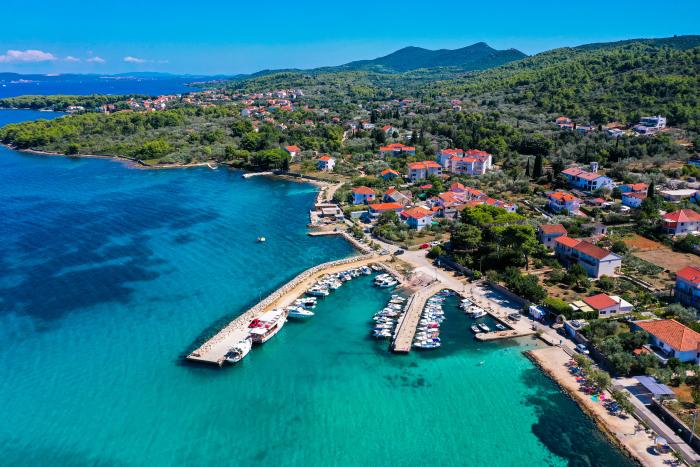
Island facts
The Island of Pašman is located in the Zadar County, it is 21.3 km long, 4.3 km wide at its widest, 63 km2 in surface and is located directly along the mainland, from which it is separated by a channel, 2-5 km wide.
Characteristics of the climate are hot and dry summers and mild and wet winters. The island belongs to the Mediterranean climate type. In January/February, the average temperature is 6.5-7 °C, while in July /August the average is 24-24.5 °C. Average insolation is 2,490 hours (county average), annual average precipitation is 800-900 mm. The island is exposed to winds from the NW, NE, and SE and the summer wind, the mistral.
Administratively, the island is divided into two municipalities - Pašman Municipality and Tkon Municipality, which together have 2,884 inhabitants. The population is distributed in 10 settlements positioned along the island's main road. The island is connected to the mainland by a ferry (drive: diesel) from the port of Tkon and from the port of Preko on the island of Ugljan, with which it is connected by a bridge. Considering the type of buildings, there are mostly family houses, with a negligible number of smaller residential buildings, where mostly apartments for tourist purposes are located. In addition to family houses for permanent residence, there are a large number of non-commercial/commercial summer residence facilities.
A significant share of the island's economy is made up of micro and small entrepreneurs in the sectors of tourism - accommodation and food preparation services, agriculture and fishing, and construction. There is no electricity production connected to the grid on the island, but all energy is supplied from the mainland via submarine cables. Electricity is the predominant energy used in households and the public sector (including heating/cooling), and traditional wood heating is still used in the majority of households, with a negligible number of installed home PV systems.
Public transport on the island is organised by buses (diesel as fuel), while the majority of other traffic is carried out by private cars (diesel/gasoline mix). On the island level, over 80% of public lighting has been replaced with LED technology and a smaller part with solar lighting. 1 charging station for EVs was built, 1 PV was installed on the building of the municipality of Tkon, and energy efficiency measures are represented in the reconstruction and renovation projects of buildings.
As part of the 30 for 2030 call the following activities are planned:
The public building decarbonisation roadmap will outline energy efficiency measures and the installation of rooftop photovoltaic systems across ten public buildings. A feasibility study for net zero entrepreneurial zones will assess the requirements for achieving net zero through energy efficiency and renewable energy, alongside the financing needs compared to a business-as-usual scenario. The public building decarbonisation roadmap will also include a concrete action plan designed to understand the financial requirements necessary to decarbonise public buildings.
In terms of energy efficiency in public lighting, a plan, feasibility study, and financing will be developed for upgrading public lighting, which will include control systems and management systems. Currently, 70% of public lighting is energy efficient according to the Sustainable Energy and Climate Action Plan (SECAP), to continue this progress to 100%.
For electric mobility, a comprehensive plan will be created for transportation services, focusing on low-energy options and the electrification of mobility and charging stations, based on information from the SECAP. This will include initiatives for bike and car sharing, as well as alternative transport solutions that reduce reliance on private cars, such as electric boats. Additionally, a network of charging stations will be established across ten villages.

